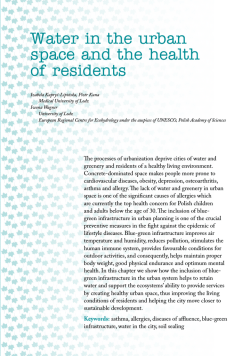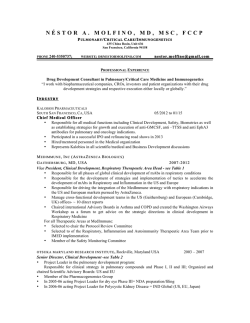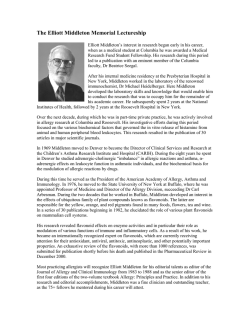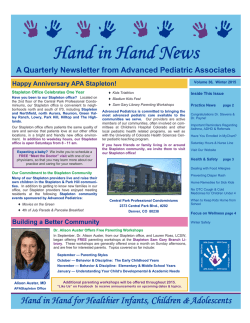
Symptom Perception in Pediatric AsthmaResistive Loading and In
Original Research ASTHMA Symptom Perception in Pediatric Asthma* Resistive Loading and In Vivo Assessment Compared Gregory K. Fritz, MD; Sue K. Adams, MA; Elizabeth L. McQuaid, PhD; Robert Klein, MD; Sheryl Kopel, MSc; Jack Nassau, PhD; and Anthony Mansell, MD Background: Inaccurate symptom perception contributes to asthma morbidity and mortality in children and adults. Various methods have been used to quantify perceptual accuracy, including psychophysical (resistive loading) approaches, ratings of dyspnea during induced bronchoconstriction, and in vivo monitoring, but it is unclear whether the different methods identify the same individuals as good or poor perceivers. The objectives of the study were as follows: (1) to compare in the same asthmatic children two methods of quantifying perceptual ability: threshold detection of added resistive loads and in vivo symptom perception; and (2) to determine which method best predicts asthma morbidity. Methods: Seventy-eight asthmatic children 7 to 16 years of age completed two threshold detection protocols in the laboratory and recorded their subjective estimates of lung function prior to spirometry at home twice daily for 5 to 6 weeks. Summary measures from both methods were compared to each other and to asthma morbidity (as measured with the Rosier asthma functional severity scale). Results: Symptom perception ability, as summarized by either method, varied greatly from child to child. Neither of the resistive load detection thresholds were significantly related to any of the three in vivo perception scores, nor were they related to asthma morbidity. The three in vivo scores did show a significant or marginal relationship with morbidity (p < 0.01, p < 0.06, and p < 0.07, respectively). Conclusions: Resistive loading techniques may not be useful in assessing symptom perception ability in children. Measuring estimates of symptoms in relation to naturally occurring asthma can identify children at risk for greater asthma morbidity. (CHEST 2007; 132:884 – 889) Key words: asthma; dyspnea; pediatric Abbreviations: PEFR ⫽ peak expiratory flow rate; Rrs ⫽ intrinsic respiratory resistance is increasing recognition that for both chilT here dren and adults with asthma, inaccurate symptom perception is a contributing factor to morbidity and mortality. Given the centrality of symptom *From the Departments of Psychiatry (Drs. Fritz, McQuaid, and Nassau, Ms. Adams, and Ms. Kopel) and Pediatrics (Drs. Klein and Mansell), Brown University School of Medicine, Providence, RI. This work was performed at Rhode Island Hospital, Providence, RI, and The University of Texas Medical Center, Tyler, TX. This work was supported by National Heart, Lung, and Blood Institute grant 2R01- HL45157. The authors have no conflicts of interest to disclose. 884 Downloaded From: http://journal.publications.chestnet.org/ on 02/06/2015 perception in the identification of asthma symptoms and subsequent management strategies, effective methods for quantifying perceptual accuracy are Manuscript received January 4, 2007; revision accepted May 6, 2007. Reproduction of this article is prohibited without written permission from the American College of Chest Physicians (www.chestjournal. org/misc/reprints.shtml). Correspondence to: Gregory K. Fritz, MD, Department of Psychiatry, Bradley Hasbro Research Center, Coro West 2.155, 1 Hoppin St, Providence, RI 02903; e-mail: [email protected] DOI: 10.1378/chest.06-2140 Original Research needed. Blunted sensitivity to added resistive loads has been shown to differentiate adults and adolescents with near-fatal asthma episodes from other asthmatics and from control subjects.1,2 A variety of methods have been developed to assess perception of respiratory sensation and dyspnea.3 One common method is to present varying external resistive or elastic loads to subjects who indicate their subjective sensations through a “detect/nondetect” response or an estimate of the magnitude of the resistance. Such extrinsic loading techniques are readily standardized and allow a number of trials at different resistances to be completed in a short period of time. However, this approach poorly replicates the physiologic, mechanical, or psychological experience of real asthma.4 Techniques in which intrinsic resistance is varied by inducing bronchoconstriction and where dyspnea is quantified with a visual analog scale or a logarithmic (Borg) scale are likely to be less artifactual. Protocols in which bronchoconstriction is induced are also well standardized and efficient, but the number of observations is typically limited and the laboratory setting may not truly represent what happens in an asthma episode. Techniques to quantify patients’ subjective awareness of naturally occurring episodes are the most realistic method of assessing respiratory perception, but also may be cumbersome, time consuming, and difficult to standardize. Conceptual and methodologic issues in this realm have been described,5 but all approaches typically require a patient to make multiple subjective symptom assessments prior to corresponding objective measures of pulmonary function. To date, there are no studies of how perception of pulmonary function indices in real life relate to either laboratory method of quantifying perceptual accuracy in either adults or children with asthma. The present study was therefore undertaken to compare two well-tested protocols for assessing symptom perception in a large number of children with asthma, and to determine the extent that each method is associated with asthma morbidity. Materials and Methods Sample The subjects in this study were 78 children aged 7 to 17 years (mean ⫾ SD, 11.4 ⫾ 2.1 years) recruited for participation in Rhode Island (n ⫽ 42) and Texas (n ⫽ 36). In Rhode Island, subjects came largely from physician and emergency department referrals. In Texas, they were recruited from an asthma summer camp. This study was reviewed and approved by the appropriate institutional review board at each site, and subjects and parents gave informed consent prior to participation. Demographic characteristics of the sample are summarized in Table 1. Asthma www.chestjournal.org Downloaded From: http://journal.publications.chestnet.org/ on 02/06/2015 Table 1—Demographic Characteristics of Participants (n ⴝ 78) Characteristics Age, yr Socioeconomic status (Hollingshead) Gender Female Male Race/ethnicity White, non-Hispanic Black, non-Hispanic Hispanic Multiracial Asthma severity Mild intermittent Mild persistent Moderate persistent Severe persistent % of Sample Mean SD Range 11.4 43.4 2.1 11.8 7–16 12–66 40 60 75 14 4 7 10 57 26 7 severity was assessed according to existing National Heart, Lung, and Blood Institute guidelines via a consensus rating by two asthma specialists: a pediatric pulmonologist (A.M.) and a pediatric allergist (R.K.). Data from parental report obtained via the Rosier asthma functional severity scale,6 and the child’s medication regimen provided the basis for the severity consensus rating in a process that we have described previously.7 Socioeconomic status was determined using the Hollingshead four-factor index of social position8; all socioeconomic levels were represented. The subject groups from Texas and Rhode Island were compared on these demographic and severity variables. The Texas sample was ethnically more diverse than the Rhode Island sample (74% minority vs 24% in Rhode Island, p ⬍ 0.01), but no other differences were found. Asthma morbidity was summarized in the Rosier asthma functional severity scale index, a composite score calculated as a mean of items assessing episode frequency, symptom frequency between episodes, and impairment during and between episodes.6 The 78 subjects constituted a subgroup of participants who had valid data for the variables included in these analyses. The subgroup was drawn from a larger sample of 121 participants. The 43 children who were excluded because of incomplete data had significantly lower socioeconomic status than the subjects included in the final data set, but no other differences were identified. Procedure Threshold Detection of Added Resistive Loads: The apparatus and procedure for the resistive loading protocol has been described in detail elsewhere.9 A subject’s own intrinsic respiratory resistance (Rrs) was measured (Jaeger Impulse Oscillometer, model LF1; Ganshorn Electronics; Niederlauer, Germany), and loads were presented as percentages of the child’s Rrs in accordance with the Weber law. The apparatus and the details of the protocol used in this study represented an improved, secondgeneration procedure incorporating attentional, motivational, and technical modification to increase the assessment validity over our first series of studies.9 Subjects were oriented to the apparatus and practiced load recognition until they demonstrated an adequate understanding of the procedure. Once familiarized, the subjects participated in two protocols, the order of which was randomly determined. In CHEST / 132 / 3 / SEPTEMBER, 2007 885 the “tracking protocol,” the first load was 100% of the subject’s Rrs. If detected, the next load was 20% lower; if not detected, the next load was 20% higher. A total of 20 loads were presented, and the “tracking threshold” was calculated as a plateau of five consecutive and alternating detections and nondetections. In the “random protocol,” subjects were presented with 33 loads in a predetermined, random order; loads ranged from 0% to 200% of Rrs. Here the threshold was defined as the load detected 50% of the time and was calculated via a linear regression of load presented and subject response (detect/nondetect). Only if the regression was statistically significant was the case assigned a “random threshold.” In Vivo Symptom Perception: Subjects were instructed to use a programmable, hand-held spirometer (Jaeger AMII; VIASYS Healthcare; Yorba Linda, CA) twice daily at home for 5 to 6 weeks. At each assessment, subjects used a screen on the side of the device to enter their subjective estimates of their respiratory state at the moment in the form of a guess of their current peak expiratory flow rate (PEFR). Once these values were entered, the device allowed the subject to proceed with spirometric assessment, and the best of three “blows” was saved with the corresponding subjective data. Many of the subjects were familiar with peak flow monitoring and their own PEFRs prior to participation in the study. All subjects, regardless of previous PEFR experience, received thorough, individualized training on the Jaeger AMII from a project staff member. Under the assumption that there might be a period of familiarization with the instrument, the data from day 1 were omitted from analysis. Experience7,10 has demonstrated that the peak flow guess is a meaningful way for the children to quantify their subjective estimates of current pulmonary function. Human subject requirements dictated that the children see their actual PEFR values at each blow; thus, the possibility of learning over the period of the study existed. However, a previous analysis7 of the subjective/objective correlation in the first half of the study period compared to the last half revealed no significant difference. Data generated during the assessment period were stored in the device and downloaded in the laboratory. The data were summarized using the asthma risk grid as previously described11 and illustrated in Figure 1. By this method, for each participant the PEFR guess and corresponding actual PEFR (both converted to percentage of personal best units) are plotted on the vertical and horizontal axes, respectively. Each point in an individual subject’s data set falls into either the “accurate zone” (subjective assessment closely approximates objective clinical status), the “danger zone” (clinically significant compromised function is missed by the patient) or the “symptom magnification zone” (reflecting oversensitivity to minor symptoms or exaggeration of symptoms). Each subject’s data are summarized as the percent of his/her total observations falling in each of the three zones. Thus each child’s perceptual ability is characterized by three scores from the asthma risk grid, and the unit of measure in subsequent analyses is the individual child (Fig 2). Data Analysis All analyses were performed using the statistical software (Statistical Software Package for Social Science, version 12.0; SPSS; Chicago, IL). Probit transformations12 were applied to variables unlikely to conform to assumptions of normality and homogeneity of variance. Specific data-cleaning procedures were implemented for threshold detection and in vivo data; details are available on request. Pearson product-moment correlations between primary study variables and demographic variables were conducted. Independent-sample t tests and univariate analysis if variance were used for categorical comparisons between demo886 Downloaded From: http://journal.publications.chestnet.org/ on 02/06/2015 The Asthma Risk Grid Accurate Zone: – boxes 1, 5, 9 & +/- 10% wedge Danger Zone: – boxes 4, 7 & 8 Symptom Magnification Zone: – boxes 2, 3 & 6 Figure 1. The asthma risk grid. PEF ⫽ peak expiratory flow. graphic and primary study variables. A series of hierarchical linear regression analyses were used to examine the independent contribution of the primary study variables (the two resistive loading thresholds and the three in vivo scores from the asthma risk grid) to the prediction of variation in asthma morbidity. Asthma severity was controlled for in the first step of the regression equations given its potential as a confounding variable. Results Means and SDs of the key predictor and outcome variables are presented in Table 2. Resistive Load Detection Consistent with our previous research,9 there was a wide range in the thresholds achieved in both 121 Total Participants Mastered RL Detection Protocol Sufficient Home Spirometry Data Complete Outcome Data No: 15 Yes: 106 No: 16 Yes: 90 No: 12 Yes: 78 Final Sample Figure 2. Sample derivation. Original Research Table 2—Descriptive Data for Primary Study Variables (n ⴝ 78) Variables Predictor In accurate zone, % In danger zone, % In symptom magnifier zone, % Random threshold, % intrinsic resistance Tracking threshold, % intrinsic resistance Outcome Baseline asthma morbidity Mean (SD) Range in Sample 76.4 (2.19) 11.7 (15.4) 12.0 (17.3) 91.6 (16.0) 3.3–100.0 0–78.1 0–96.7 46.0–118.6 104.9 (73.0) 10–330.2 1.4 (1.0) 0–4.3 protocols. By definition of the sample, all 78 subjects achieved a valid threshold in at least one of the protocols. For the random protocol, 83% (n ⫽ 65) attained a threshold, which averaged 92% of intrinsic resistance (range, 46 to 119%). In the tracking protocol 94% (n ⫽ 73) of the subjects achieved a threshold, which averaged 105% of intrinsic resistance (range, 10 to 330%). Associations among demographic variables and asthma severity to both random and tracking thresholds were explored, and two significant relationships were identified. Children who achieved random thresholds were significantly older than those who did not (mean age, 11.6 years vs 10.2 years, respectively; p ⬍ 0.05). Children with mild intermittent asthma had higher random thresholds than those with other levels of asthma severity (p ⬍ 0.01). In Vivo Symptom Perception The subjects averaged 52 subjective/objective data point pairs (range, 21 to 122) using the portable spirometer over the assessment period, which were plotted on the grid for each subject. The scores reflected considerable between-subject variability in symptom perception accuracy. On average, across all subjects, 76% of the points were in the accurate zone, but this percentage ranged from 3 to 100% for individual children. Of the points in the accurate zone, on average 22% were when the patient was compromised (ie, objective PEFR ⬍ 80% of per- sonal best). The subjects averaged 12% of points in the danger zone (range, 0 to 78%) and 12% of points in the symptom magnification zone (range, 0 to 97%). There were no significant associations between demographic variables and symptom perception scores. Relation Between Resistive Load Detection Thresholds and In Vivo Symptom Perception Scales Table 3 summarizes the correlations between primary study variables. Resistive load detection thresholds for the random and tracking protocols were significantly and positively intercorrelated. Similarly, the three grid zone scores were highly intercorrelated in the expected directions. We expected those with high danger zone scores to have relatively higher thresholds, those with high symptom magnification zone scores to have low thresholds, and those with high accurate zone scores to have mid range thresholds. Neither of the resistive load detection thresholds, however, was related to any of the three scores from the in vivo method of assessing symptom perception. Hierarchical linear regression techniques were used to determine which method of quantifying perceptual ability had the best predictive validity in terms of asthma morbidity. These results are summarized in Table 4. The accurate zone score significantly predicted baseline asthma morbidity, whereas the danger zone score and symptom magnification score were marginal predictors of morbidity. In contrast, neither of the resistive loading thresholds approached predictive significance. Essentially the same results were obtained when the analyses were performed when not controlling for asthma severity. Discussion Three studies in the literature have compared resistive loading techniques with laboratory-induced bronchoconstriction, with mixed results. Two studies13,14 found a significant relationship between the methods of assessing perception, and one study15 did not. The present study is the first to examine the Table 3—Significant Bivariate Correlations of Primary Study Variables Variables 1. 2. 3. 4. 5. 1. Random Threshold 2. Tracking Threshold 3. Accurate Zone 4. Danger Zone 5. Symptom Magnifier 0.64* 0.02 ⫺ 0.08 ⫺ 0.09 0.21 ⫺ 0.63* 0.09 ⫺ 0.06 ⫺ 0.73* ⫺ 0.01 Random threshold Tracking threshold Accurate zone Danger zone Symptom magnifier zone *p ⬍ 0.01. www.chestjournal.org Downloaded From: http://journal.publications.chestnet.org/ on 02/06/2015 CHEST / 132 / 3 / SEPTEMBER, 2007 887 Table 4 —Individual Multiple Linear Regression Models for Resistance Loading and In Vivo Symptom Perception Predicting Asthma Morbidity, Controlling for Asthma Severity* Baseline Morbidity Predictors Model 1 Asthma severity Random threshold Model 2 Asthma severity Tracking threshold Model 3 Asthma severity Accurate zone Model 4 Asthma severity Symptom magnifier zone Model 5 Asthma severity Danger zone R2 p Value 0.34 0.10 0.10 0.11 0.01† 0.45 0.35 0.05 0.13 0.13 0.002† 0.69 0.37 ⫺ 0.29 0.13 0.22 0.001† 0.006† 0.37 0.20 0.13 0.17 0.001† 0.07 0.37 0.20 0.13 0.17 0.001† 0.06 ß *Each row represents results of a separate regression. In each case, asthma severity was entered on the first step. †p ⬍ 0.01. relationship between naturalistic and psychophysical approaches to quantifying symptom perception in asthmatic children. In a reasonably large sample using the best equipment available in well-validated protocols, we found no relationship between the resistive load detection thresholds and summary scores from the in vivo method. Moreover, the thresholds bore no relationship to asthma morbidity, whereas the in vivo method explained a small but significant portion of the variance in morbidity. Clearly, the two assessment approaches, when applied in children, do not measure the same thing. These findings are consistent with the work of Moy et al,16 who reported qualitative differences in dyspnea reports when bronchoconstriction was compared to external resistive loading. Despite the methodologic efficiency and theoretical appeal of a resistive loading paradigm, an approach that measures sensitivity to naturally occurring pathophysiology, whether related to bronchoconstriction or airway inflammation, is likely to be more useful in quantifying symptom perception in children with asthma. This study did not determine the factors behind the lack of a relationship between the two perceptual measures. Certainly the intrinsic causes of bronchoconstriction during asthma are different from the relatively pure stimulation of the mechanoreceptors in respiratory muscles that occurs with resistive loading. An asthma episode includes physiologic, psychological, and situational cues that are absent in 888 Downloaded From: http://journal.publications.chestnet.org/ on 02/06/2015 a laboratory resistive loading protocol. The asthmatic subjects in the present study were not recruited or classified for analytic purposes into specific subgroups. Therefore, we cannot rule out the possibility that the resistive loading thresholds are meaningful and predictive for a subgroup of the asthmatic population, such as those who have experienced an episode of life threatening asthma. However, the full range of asthma severity was represented in this sample, making the results more generalizable to the whole population of children with asthma. The 78 subjects in this study were much younger (mean age, 11.4 years) than the subjects in other studies that have found associations between psychophysical indexes and methacholine-induced bronchoconstriction13–15 or clinical asthma characteristics.1,17 It is possible that our subjects’ relative cognitive immaturity may have made the resistive loading paradigm more difficult and prone to artifact during administration than is the case with adults. The finding that children who achieved random thresholds were older than those who did not support this idea. A number of other study limitations deserve mention. First, only 80% of the children in the final study group achieved thresholds in both protocols. Despite several years of effort to refine the apparatus, improve the participant orientation, perfect the administration of the stimuli, and maximize children’s level of involvement, some children could not produce meaningful thresholds with this laboratory approach.9 Missing data in this study were not randomly distributed: excluded children had lower socioeconomic status, and the subjects were primarily white, factors that may limit the generalizability of the findings. Second, the use of PEFR in the in vivo protocol, while most familiar to the subjects, constitutes a limitation because it is effort dependent and may not reflect small airway involvement. From a clinical perspective and consistent with other research, this study identified a number of asthmatic subjects who are poor perceivers of changes in pulmonary function. These subjects, when identified by in vivo assessment of symptom perception, had more asthma-related morbidity than their peers who were better perceivers. Recent research18 suggesting that antiinflammatory medications should be administered on an as-needed basis further highlights the importance of accurate symptom perception. The question of whether perception of asthma symptoms can be improved with training remains to be answered, but an intervention aimed at doing so by improving threshold detection skills would be appear to be ill advised, given the lack of a relationship with in vivo symptom perception. Original Research References 1 Kikuchi Y, Okabe S, Tamura G. Chemosensitivity and perception of dyspnea in patients with a history of near-fatal asthma. N Engl J Med 1994; 330:1329 –1334 2 Kifle Y, Seng V, Davenport PW. Magnitude estimation of inspiratory resistive loads in children with life-threatening asthma. Am J Respir Crit Care Med 1997; 156:1530 –1535 3 Banzett R, Dempsey J, O’Donnell D, et al. Symptom perception and respiratory sensation in asthma. Am J Respir Crit Care Med 2000; 162:1178 –1182 4 Kelson S, Prestel T, Cherniack N, et al. Comparison of the respiratory responses to external resistive loading and bronchoconstriction. J Clin Invest 1981; 67:1761–1768 5 Fritz GK, Yeung A, Wamboldt M, et al. Conceptual and methodologic issues in quantifying perceptual accuracy in childhood asthma. Pediatric Psychology 1996; 21:153–173 6 Rosier MJ, Bishop J, Nolan T, et al. Measurement of functional severity of asthma in children. Am J Respir Crit Care Med 149:1434 –1441 7 Fritz GK, McQuaid EL, Spirito A, et al. Symptom perception in pediatric asthma: relationship to functional morbidity and psychological factors. J Am Acad Child Adolesc Psychiatry 1994; 35:1033–1041 8 Hollingshead A. Four-factor index of social status. New Haven, CT: Department of Sociology, Yale University, 1975 9 Fritz GK, Rosenblum K, Klein RB, et al. Improved methodology for threshold detection studies in asthmatic children. J Psychophysiol 2001; 15:190 –197 www.chestjournal.org Downloaded From: http://journal.publications.chestnet.org/ on 02/06/2015 10 Fritz GK, Klein RB, Overholser JC. Accuracy of symptom perception in childhood asthma. J Dev Behav Pediatrics 1990; 11:69 –72 11 Klein RB, Walders N, McQuaid EL, et al. The asthma risk grid: clinical interpretation of symptom perception. Allergy Asthma Proc 2004; 25:1– 6 12 Cohen J, Cohen P. Statistical power analysis for the behavioral sciences. Hillsdale, NJ: Erlbaum, 1983 13 Yamamoto H, Inaba S, Nishimura M, et al. Relationship between the ability to detect added resistance at rest and breathlessness during bronchoconstriction in asthmatics. Respiration 1987; 52:42– 48 14 Julius SM, Davenport KL, Davenport PW. Perception of intrinsic and extrinsic respiratory loads in children with life-threatening asthma. Pediatr Pulmonol 2002; 34:425– 433 15 Bijl-Hofland I, Cloosterman S, vanSchayck C, et al. Perception of respiratory sensation assessed by means of histamine challenge and threshold loading tests. Chest 2000; 117:954 – 959 16 Moy ML, Weiss JW, Sparrow D, et al. Quality of dyspnea in bronchoconstriction differs from external resistive loads. Am J Respir Crit Care Med 2000; 162:451– 455 17 Davenport P, Kifle Y. Inspiratory resistive load detection in children with life-threatening asthma. Pediatr Pulmonol 2001; 32:44 – 48 18 Rabe KF, Pizzichini E, Stallberg B, et al. Budesonide/ formoterol in a single inhaler for maintenance and relief in mild-to-moderate asthma: a randomized, double-blind trial. Chest 2006; 1299:246 –256 CHEST / 132 / 3 / SEPTEMBER, 2007 889
© Copyright 2026




